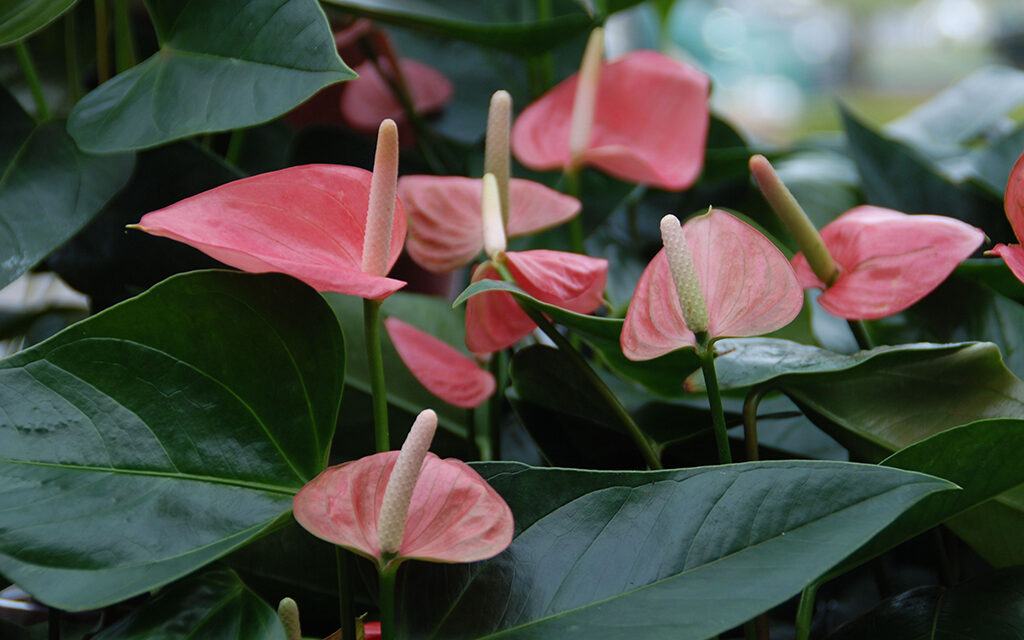by Melinda Myers
Chocolates and roses are synonymous with Valentine’s Day. They are always a welcome gift but maybe this is the year you decide to give your Valentine something different.
Consider an indoor plant with heart-shaped leaves or flowers. Anthuriums are an easy-to-grow long blooming indoor plant. The red, pink, or white heart-shaped flowers rise above glossy green leaves. Grow it in a brightly lit location out of direct sunlight and water when the soil is slightly dry.
Heart-shaped leaves and colorful flowers of the florist cyclamen (Cyclamen persicum) make it an excellent choice. Its pink, red, purple, or white flowers rise above variegated leaves of green and silver. It prefers cool, draft-free locations and bright indirect light. Allow the soil to almost dry between waterings.
Valentine hoya, also known as Sweetheart hoya (Hoya kerrii), is usually sold as a single rooted leaf in a small container. It eventually grows into a vining plant and requires the same care as other hoyas. Grow it in a warm location with bright indirect light and well-drained soil.
String of hearts (Ceropegia woodii) is just that, a thin vine dotted with an abundance of small heart-shaped leaves. The leaves are dark green with silver highlights adding to its appeal. Grow it in bright light with well-drained soil and water it when the soil is dry.
Beginning and experienced gardeners will appreciate a low-maintenance pothos or philodendron with heart-shaped leaves. Select one of the variegated philodendron varieties like Brasil or Neon pothos with bright lime green leaves for a bit different look.
Purchase or create a heart-shaped topiary. At your favorite garden center, you’ll find many ready-to-buy or all the necessary materials to plant your own.
All you need is a pot with drainage holes, a couple of vining-type plants like wire vine or English ivy, and a piece of heavy gauge wire or a pre-formed heart-shaped topiary frame.
Small-leafed ivies and wire vines are easy to train into attractive topiaries. Look for small plants with long branches for immediate impact.
Bend the wire into a heart shape with one or two legs that will extend into the container. Fill the bottom half of the container with a well-drained potting mix. Set the topiary frame in place. Locate the plants in the container so the stems can be trained up either side of the heart. Cover the roots with soil and water. Secure the stems to the wireframe and add a decorative stone mulch, if desired.
If your recipient is an avid gardener, they may prefer assembling their own Valentine’s topiary. Just provide all the materials and directions wrapped in pretty paper.
If you opt for fresh flowers, make sure to get the most from your floral investment. Look for the freshest flowers possible. A whiff of the water will let you know if the flowers are fresh and have been properly tended.
Look for upright and perky flowers with lots of firm buds that are just starting to open. Avoid cut flowers with drooping discolored leaves and slimy stems.
Give the recipient a packet of floral preservatives to add to some fresh water. Encourage them to remove any lower leaves and recut the stems before placing them in a clean vase.
If the roses bend at the neck soon after purchase, there is an easy cure. Remove them from their vase, recut the stems, and submerge the whole rose – stem, leaves, flowers, and all – in a sink or tub of warm water. Leave the roses submerged for 30 minutes. Recut the stem and place it in a clean vase with fresh water and a floral preservative.
Always protect your living Valentine’s gift when transporting it between the store, your home, and your Valentine. Wrap plants or cut flowers to protect them from the weather and never leave them in a cold or hot car.
Whatever plant or flowers you select, you are sure to generate a smile and boost your Valentine’s spirits for the coming week.
Melinda Myers has written more than 20 gardening books, including Midwest Gardener’s Handbook, 2nd Edition and Small Space Gardening. She hosts The Great Courses “How to Grow Anything” instant video and DVD series and the nationally syndicated Melinda’s Garden Moment radio program. Myers is a columnist and contributing editor for Birds & Blooms magazine. Myers’ website is www.MelindaMyers.com.





